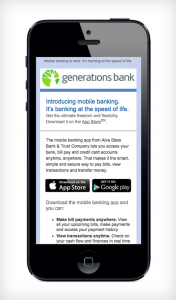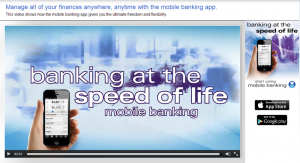

J&C Blog
Find all the latest marketing trends on the J&C Blog.

Find all the latest marketing trends on the J&C Blog.
It might be surprising to learn that 80% of all time on iOS and Android connected devices is spent using a mobile app.1 After giving this a little thought you’ll realize mobile apps are something we use more often than we think. Mobile apps simplify our lives, make us smarter shoppers, enhance our productivity and even change the way we watch television.
It’s also quite interesting to see how much mobile app development has outpaced the marketing of mobile apps. Many marketers struggle with driving customers to download. This blog explores that challenge and how effective email marketing can overcome it.
We’ll review 4 keys that illustrate how J&C helped iPay Solutions drive downloads of its white-labeled mobile banking app. This includes a review of techniques that delivered a seamless customer experience and path to downloading. We’ll also cover mandatory best practices that ensured campaign success.
1. Create responsively designed emails for optimal mobile viewing
 The quickest way to get customers to download an app is to drive them to an app store from their smart device. This may seem like a no-brainer, but some marketers overlook optimizing emails for mobile viewing.
The quickest way to get customers to download an app is to drive them to an app store from their smart device. This may seem like a no-brainer, but some marketers overlook optimizing emails for mobile viewing.
With more than 50% of all customers accessing iPay Solutions’ emails on a mobile device, J&C prioritized email content so that devices would display the most critical information first. This ensured the recipient could immediately comprehend the nature of the communications and seamlessly drive them to their respective app store directly from their smart device.
It’s important to recognize mobile optimization as a mandatory best practice, especially when promoting a mobile product. Customers expect downloading to be turnkey and relatively painless. If customers can’t effortlessly understand and get what they need from their phone, chances are they’ll move on without downloading. Check out Responsive Design Drives the Future of Mobile to learn more on optimizing emails for mobile viewing.
2. Display app store badges for accessibility and credibility
When it comes to promoting a new app, there are accessibility and credibility concerns that need to be addressed. Customers often question the legitimacy of a new app and are quick to dismiss it, especially if they don’t think the app is compatible with their smart device.
Beyond personalizing email communications with your brand, the best way to overcome the challenge is to feature Apple’s App Store and Google’s Google Play badges prominently. Doing so elevates the credibility of your mobile product. Customers will instantly recognize the familiar icons they trust and associate with their specific smart device.
Featuring the Apple and/or Google brand within your email communications is a process that requires a number of reviews and approvals. It includes working with Apple and Google on obtaining consent to feature their identities, logos and app store badges across all elements of your campaign.
3. Personalize emails to meet product delivery needs
 Since iPay’s product was a white-labeled app that would be distributed on behalf of financial institutions, it was essential that email communications be personalized as much as possible. And given that not all financial institutions offered an Apple and Google app, email communications needed to be dynamically personalized. This included the financial institution name, logo, unique contact number, legal copy and variable creative that would swap in App Store and/or Google Play badges where appropriate.
Since iPay’s product was a white-labeled app that would be distributed on behalf of financial institutions, it was essential that email communications be personalized as much as possible. And given that not all financial institutions offered an Apple and Google app, email communications needed to be dynamically personalized. This included the financial institution name, logo, unique contact number, legal copy and variable creative that would swap in App Store and/or Google Play badges where appropriate.
Personalization was a big key to the campaign’s overall success. More than one-third of recipients opened the email and more than 6 percent downloaded the app.
Check out Impact of Personalizing Email to learn more about how personalization drives higher response rates.
4. Link to educational resources for higher conversions
A fundamental truth in marketing is that education leads to higher response rates and conversions. The more informed customers are about a product, the more inclined they’ll be to take action. As a new product offering, the mobile banking app had to overcome some educational challenges. Many online banking users were unfamiliar with mobile banking and set in their ways, preferring to stay online rather than make the switch to mobile.
 To address this, J&C tackled customer concerns head-on. This included linking the email campaign to a mobile banking demo that alleviated mobile banking safety and security concerns, provided background on how the app worked and gave instructions on how to download.
To address this, J&C tackled customer concerns head-on. This included linking the email campaign to a mobile banking demo that alleviated mobile banking safety and security concerns, provided background on how the app worked and gave instructions on how to download.
In addition to the educational demo, a mobile banking FAQ page was developed. This supplemented the demo and gave customers a quick hitting resource that answered their questions. The performance of the FAQ page was surprising with almost 40% of FAQ viewers downloading the app.
As email marketing continues to evolve, it’s important to keep up with the latest info.
Sources:
1. 2012. Flurry Analytics, comScore, NetMarketShare
Topics: Email Marketing
303 E Wacker Drive, Suite 2030
Chicago, IL 60601
Phone: 312-894-3000
Fax: 312-894-3005